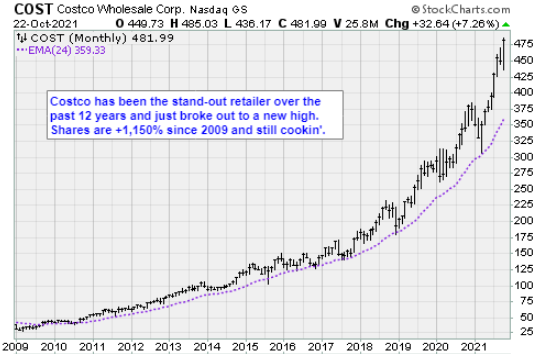Markets opened this week coming off a terrific week with a new high for the Dow Jones Industrial Average, while the S&P 500 (SPX) closed down 0.1% at 4,544, says Jon Markman, growth-stock specialist and editor of Strategic Advantage.
The benchmark S&P 500 is on a three-week winning streak and bears are running scared. They know this is a seasonally strong time frame and that professionals who are underinvested need to play catch up with the runaway indexes.
The benchmark is up 21% in 2021. Nothing motivates institutional money managers more than trailing the unmanaged index heading into November. Stocks may still move sideways to marginally lower in the near term as gains are digested yet the trend is undeniably higher.
The S&P 500 should push into the 4,700 level in December. Critical support is 4,450.
The Dow owed its new high to a big gain by American Express (AXP) following upside quarterly earnings. The Amex jump blunted damage from a plunge in Intel (INTC) shares after the chipmaker issued disappointing fourth quarter profit guidance. What a mess at Intel.
The Nasdaq dropped 0.8% with Facebook (FB) down 5% while Google (GOOG) and Amazon (AMZN) shed 2.9% apiece following Snap's (SNAP) icy online advertising forecast, which sent that social media stock 27% lower.
The 10-year US Treasury yield slipped two basis points to 1.66%, just off a five-month high. West Texas Intermediate crude oil rose $1.50 to $84 per barrel, a seven-year high.

Breadth favored decliners by a thin 4-3 margin and there were 570 new one year highs vs 204 new lows. Topping the new high honor roll were Tesla, up 1.75% after its solid earnings report, UnitedHealth Group, Home Depot, Netflix, Accenture, Costco, Broadcom, Blackstone, Intuit, American Express, Service Now, and Anthem. Great leadership.
American Express topped earnings and revenue estimates on card spending that was up 19% in the quarter from two years earlier, while spending by millennial and Gen Z cardholders rose 38% over the same span. "We also saw a continued rebound in travel and entertainment spending, with restaurant spending notably resilient, growing above pre-pandemic levels in the quarter," the company said. Shares rose 5.5%.
Intel noted the widespread supply chain blockages in providing its downbeat outlook, saying its customers could not secure a sufficient supply of integrated circuits amid shortages, lowering demand for its complementary chips. But it also lowered the longer-term margin guidance as the company embarks on aggressive investments in manufacturing. Shares fell nearly 12%.
Supply chain pain spread to cyberspace Friday with Snap's CEO saying potential advertisers are currently more focused on locating labor and supply to meet demand than on attracting new customers.
Longtime highs in energy prices fueled Schlumberger's (SLB) bullish outlook for 2022 after the oilfield services giant met third-quarter earnings estimates while falling shy on revenue that was up 11% year over year.
"The industry macro fundamentals have visibly strengthened this year, particularly in recent weeks—with demand recovery, oil and gas commodity prices at recent highs, low inventory levels, and encouraging trends in pandemic containment efforts," Schlumberger CEO said. "Absent a recession or pandemic-related setback, these favorable conditions are expected to materially drive investment over the next few years—particularly internationally—and result in exceptional multi-year capital spending growth globally, both on land and offshore."
Recent gains in used-car prices driven by a shortage of new autos amid semiconductor supply shortfalls and likely increases in airfares in the month ahead are likely to push core annual inflation to about 6% at its peak in January or February, said Ian Shepherdson of Pantheon Macro in a research note. "If unit labor costs remain controlled, the 'transitory' story is sustainable, but expect pressure on the Fed," he wrote.





















